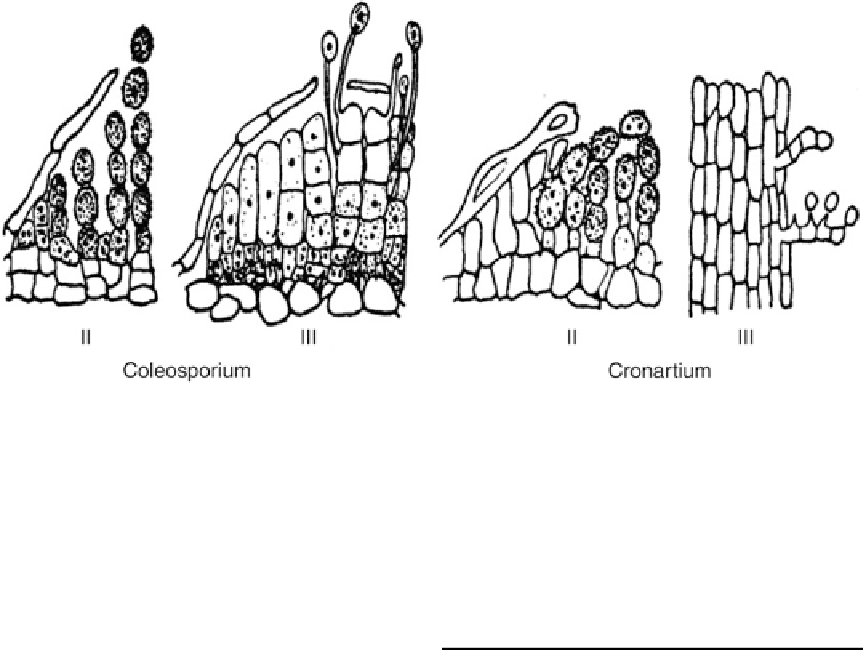Biology Reference
In-Depth Information
Fig. 1
Pine Rusts.
Coleosporium asterum
, uredial (II) and telial (III) stages on aster, teliospores germinating
in situ
.
Cronartium ribicola
, II and III stages on currant
Coleosporium ipomoeae 0, I on southern and
Chihuahua pines; II, III on moonflower, morning-
glory, sweet potato, jacquemontia, and
quamoclit; most abundant in warmer regions.
The uredia are orange-yellow, telia deep reddish
orange on sweet potato.
Coleosporium jonesii 0, I on pinon pine; II, III
on flowering currant and gooseberry.
Coleosporium lacinariae 0, I on loblolly,
longleaf, and pitch pines; II, III on liatris.
Coleosporium mentzeliae On mentzelia.
Coleosporium minutum 0, I on loblolly and
spruce pines; II, III on forestiera.
Coleosporium pacificum 0, I on Monterey,
Coulter, and Jeffrey pines; II, III on marigold,
sunflower, tarweed, and other composites.
Coleosporium pinicola III on Virginia or scrub
pine.
Coleosporium tussilaginis 0, I on pitch, red,
and Virginia pines; II, III on campanula,
lysimachia, and specularia, Underside of bluebell
leaves are covered with orange to reddish brown
pustules. Leaves dry; plants are stunted.
Coleosporium tussilaginis 0, I on Scotch pine;
II, III on sow-thistle.
Coleosporium tussilaginis 0, I, unknown; II, III
on senecio.
Coleosporium vernoniae 0, I on two-and three-
needle pines in South; II, III on elephantopus.
Coleosporium vernoniae 0, I on various two-
and three-needle pines; II, III on ironweed.
Coleosporium viburni 0, I, unknown; II, III on
Viburnum
spp.
Cronartium (Causing Blister Rusts)
Melampsoraceae. Heteroecious; pycnia and aecia
on trunk and branches of pine; uredia, telia on
herbaceous or woody dicotyledons.
Pycnia on stems, caeomoid, forming blisters
beneath host cortical layer; dehiscent by longitu-
dinal slits in bark; aecia on trunks, erumpent, with
peridium sometimes dehiscent at apex, more
often splitting irregularly or circularly at side;
aeciospores ellipsoid with coarsely warted
walls, sometimes with smooth spot on one side.
Uredia on underside of leaves or on stems of
herbaceous hosts; delicate peridium, dehiscent
at first by a central pore; urediospores borne sin-
gly on pedicels, ellipsoidal with spiny walls; telia
erumpent, often coming from uredia; catenulate,
one-celled teliospores often form a extended
cylindrical or filiform column, horny when dry
(see
Fig. 1
).
Blister rusts are characterized by swellings
that are globose, subglobose, or fusiform,
depending on species. A rust on a pine stem is


